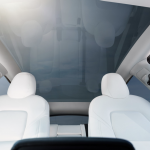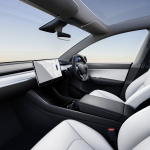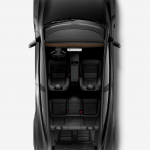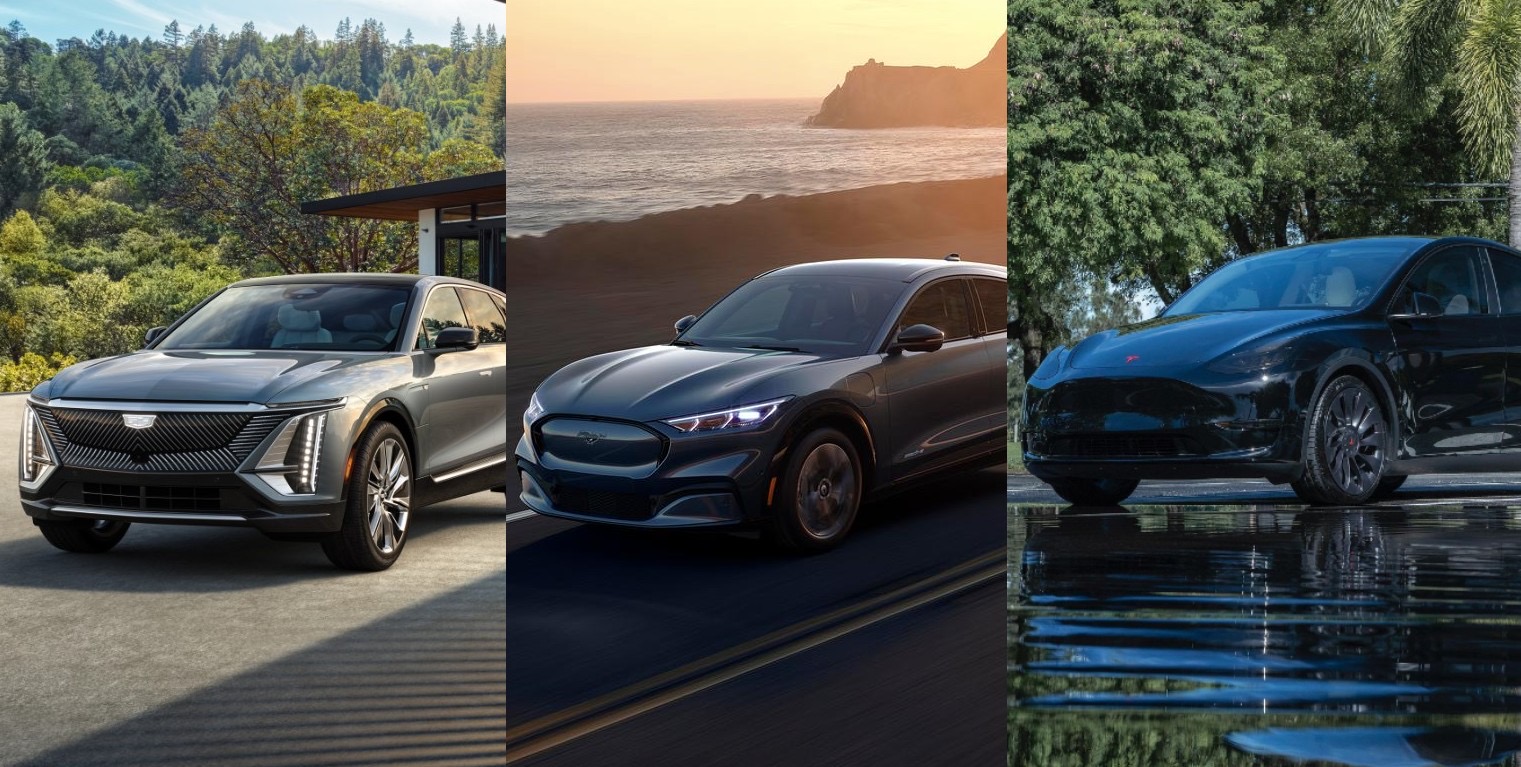
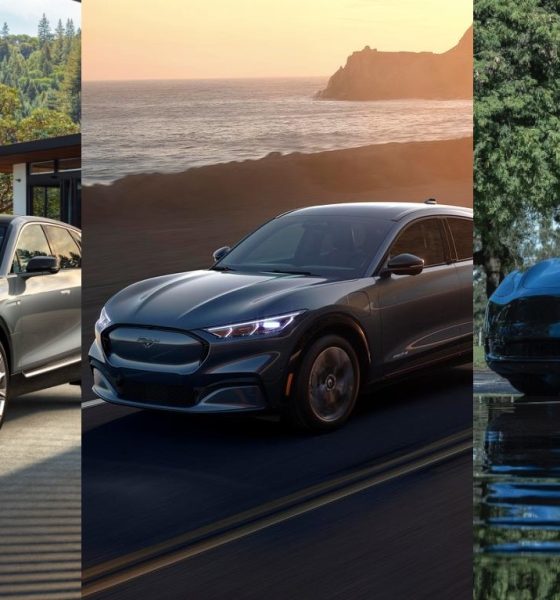
News
Cadillac Lyriq vs Ford Mach-E vs Tesla Model Y: Features, price, and tech comparison
GM has entered the premium all-electric crossover SUV market, and its flagship vehicle is the rather eye-catching Cadillac Lyriq. Poised to hit the roads in the first half of 2022, the Lyriq will be entering an market already saturated by formidable opponents like the Ford Mustang Mach-E and the best-selling Tesla Model Y.
With the competiton in the EV SUV market in mind, it’s important to know how the Cadillac Lyriq stacks up against two of the strongest entries in the premium all-electric crossover segment today. Below is a comparison of the Cadillac Lyriq, the Ford Mustang Mach-E (both in SR and ER variants), and the Tesla Model Y Long Range Dual Motor AWD.
Size and Weight
The Cadillac Lyriq is quite a hefty vehicle, dwarfing the Mach-E and the Model Y with its 196.7-inch length, 77.8-inch width, and a 121.8-inch wheelbase. In comparison, the Mach-E has a length of 186.0 inches, and width of 74.0 inches, and a wheelbase of 117.0 inches. The Model Y has a length of 187.0 inches, a width of 75.6 inches, and a wheelbase of 113.8 inches. The Lyriq is precisely the same height as the Model Y at 63.9 inches, making it taller than the Mach-E, which has a height of 63.0 inches.
All this size translates to the Cadillac Lyriq’s curb weight, which also stands far above the Mach-E and the Model Y. The Lyriq has some serious heft at 5,610 pounds, while the Mach-E and Model Y are far lighter at 4,394-4,890 pounds for the Ford and 4,416 pounds for the Tesla.
- (Credit: Tesla)
- (Credit: Tesla)
- (Credit: Tesla)
Interior Dimensions and Cargo Space
While the Cadillac Lyriq is significantly larger than the Mustang Mach-E and the Model Y outside, it is comparable to its two rivals when it comes to the interior. While it edges out its rivals in legroom, shoulder room, and hip room, in terms of headroom, the Lyriq is actually behind its competitors, with 38.6 inches in the front and 37.7 inches at the rear. Despite being smaller physically, the Mach-E features a front headroom of 40.4 inches and rear headroom of 39.3 inches. The Model Y has significantly more headroom than the Lyriq as well, with 41.0 inches at the front and 39.4 inches at the rear.
This trend continues all the way to the Lyriq’s cargo space when its second-row seats are folded down. With this setup, the Lyriq boasts 60.8 cubic feet of cargo space, which is slightly higher than the Mach-E’s 59.7 cubic feet, but significantly behind the Model Y, which offers a whopping 68 cubic feet of cargo space with the second-row seats folded down.
Battery and Estimated Range
The Cadillac Lyriq features a large 100 kWh battery, which GM notes should provide the all-electric SUV with about 300 miles of range. The Mustang Mach-E offers two battery sizes: a 75.7 kWh standard range unit that gives drivers about 211 miles of range and a 98.8 kWh extended range battery that provides 300 miles of range. The Model Y taps into Tesla’s vast experience as an all-electric car maker by drawing out 326 miles of EPA-rated range with a 75 kWh battery pack.
Performance and 0-60 Times
GM noted that the Lyriq’s electric motor produces 340 hp and 325 lb-ft of torque. GM’s estimates might seem conservative when compared to the Mach E, which produces 346 hp and 428 lb-ft of torque in its ER AWD version, and the Model Y Long Range, which has 384 hp and 376 lb-ft of torque. GM is also yet to release the 0-60 mph figures for the Lyriq, though Roadshow estimates that the vehicle, thanks to its large size and lower power, would likely be significantly slower than both the Mach-E Extended Range AWD and the Model Y Long Range, which boast a 5.5-second and 4.8-second 0-60 mph time, respectively.
Driver-Assist Technologies
GM’s brochure for the Lyriq notes that the all-electric SUV is equipped with the company’s award-winning Super Cruise, “the first truly hands-free driver assistance feature for compatible roads.” Super Cruise is impressive, though it only works on pre-mapped roads, and it requires users to have an active Cadillac Connected Services plan. Super Cruise-equipped vehicles like the Lyriq include 3 years of connectivity to support functionality, after which a Connected Services Plan must be purchased.
Ford, for its part, has recently announced its BlueCruise, a Level 2 driver-assist technology that also, in the carmaker’s words, offers a “true hands-free driving experience while in Hands-Free Mode that does not require a driver’s hands to stay in contact with the steering wheel, unless prompted by vehicle alerts.” Mach-E customers would be able to purchase BlueCruise software, including a three-year service period, for $600 in the second half of 2021, when the service is expected to launch.
Last but not least, the Tesla Model Y is equipped with basic Autopilot for free, though customers could opt-in for the carmaker’s Full Self-Driving suite for a $10,000 charge. Basic Autopilot includes key functions like Traffic-Aware Cruise Control and Autosteer, while FSD includes advanced features like Navigate on Autopilot with Auto Lane Change, Autopark, Summon, and Traffic Light and Stop Sign Control. Unlike Ford and GM, however, Tesla’s Autopilot and FSD suite are, in their current iteration, not hands-free.
Price
The Cadillac Lyriq stays true to its brand, starting at $59,990. That’s far more expensive than the Mustang Mach-E, which starts at a more modest $43,995. The Tesla Model Y Long Range slots right in the middle of the Lyriq and Mach-E, with its current starting price of $51,690 including destination charges.
Check out the Cadillac Lyriq’s brochure below.
My23 Lyriq PDF Brochure v14 Final by Maria Merano on Scribd
Do you have anything to share with the Teslarati Team? We’d love to hear from you, email us at tips@teslarati.com or reach out to me at maria@teslarati.com.

News
Tesla FSD fleet is nearing 7 billion total miles, including 2.5 billion city miles
As can be seen on Tesla’s official FSD webpage, vehicles equipped with the system have now navigated over 6.99 billion miles.

Tesla’s Full Self-Driving (Supervised) fleet is closing in on almost 7 billion total miles driven, as per data posted by the company on its official FSD webpage.
These figures hint at the massive scale of data fueling Tesla’s rapid FSD improvements, which have been quite notable as of late.
FSD mileage milestones
As can be seen on Tesla’s official FSD webpage, vehicles equipped with the system have now navigated over 6.99 billion miles. Tesla owner and avid FSD tester Whole Mars Catalog also shared a screenshot indicating that from the nearly 7 billion miles traveled by the FSD fleet, more than 2.5 billion miles were driven inside cities.
City miles are particularly valuable for complex urban scenarios like unprotected turns, pedestrian interactions, and traffic lights. This is also the difference-maker for FSD, as only complex solutions, such as Waymo’s self-driving taxis, operate similarly on inner-city streets. And even then, incidents such as the San Francisco blackouts have proven challenging for sensor-rich vehicles like Waymos.
Tesla’s data edge
Tesla has a number of advantages in the autonomous vehicle sector, one of which is the size of its fleet and the number of vehicles training FSD on real-world roads. Tesla’s nearly 7 billion FSD miles then allow the company to roll out updates that make its vehicles behave like they are being driven by experienced drivers, even if they are operating on their own.
So notable are Tesla’s improvements to FSD that NVIDIA Director of Robotics Jim Fan, after experiencing FSD v14, noted that the system is the first AI that passes what he described as a “Physical Turing Test.”
“Despite knowing exactly how robot learning works, I still find it magical watching the steering wheel turn by itself. First it feels surreal, next it becomes routine. Then, like the smartphone, taking it away actively hurts. This is how humanity gets rewired and glued to god-like technologies,” Fan wrote in a post on X.
News
Tesla starts showing how FSD will change lives in Europe
Local officials tested the system on narrow country roads and were impressed by FSD’s smooth, human-like driving, with some calling the service a game-changer for everyday life in areas that are far from urban centers.

Tesla has launched Europe’s first public shuttle service using Full Self-Driving (Supervised) in the rural Eifelkreis Bitburg-Prüm region of Germany, demonstrating how the technology can restore independence and mobility for people who struggle with limited transport options.
Local officials tested the system on narrow country roads and were impressed by FSD’s smooth, human-like driving, with some calling the service a game-changer for everyday life in areas that are far from urban centers.
Officials see real impact on rural residents
Arzfeld Mayor Johannes Kuhl and District Administrator Andreas Kruppert personally tested the Tesla shuttle service. This allowed them to see just how well FSD navigated winding lanes and rural roads confidently. Kruppert said, “Autonomous driving sounds like science fiction to many, but we simply see here that it works totally well in rural regions too.” Kuhl, for his part, also noted that FSD “feels like a very experienced driver.”
The pilot complements the area’s “Citizen Bus” program, which provides on-demand rides for elderly residents who can no longer drive themselves. Tesla Europe shared a video of a demonstration of the service, highlighting how FSD gives people their freedom back, even in places where public transport is not as prevalent.
What the Ministry for Economic Affairs and Transport says
Rhineland-Palatinate’s Minister Daniela Schmitt supported the project, praising the collaboration that made this “first of its kind in Europe” possible. As per the ministry, the rural rollout for the service shows FSD’s potential beyond major cities, and it delivers tangible benefits like grocery runs, doctor visits, and social connections for isolated residents.
“Reliable and flexible mobility is especially vital in rural areas. With the launch of a shuttle service using self-driving vehicles (FSD supervised) by Tesla in the Eifelkreis Bitburg-Prüm, an innovative pilot project is now getting underway that complements local community bus services. It is the first project of its kind in Europe.
“The result is a real gain for rural mobility: greater accessibility, more flexibility and tangible benefits for everyday life. A strong signal for innovation, cooperation and future-oriented mobility beyond urban centers,” the ministry wrote in a LinkedIn post.
News
Tesla China quietly posts Robotaxi-related job listing
Tesla China is currently seeking a Low Voltage Electrical Engineer to work on circuit board design for the company’s autonomous vehicles.

Tesla has posted a new job listing in Shanghai explicitly tied to its Robotaxi program, fueling speculation that the company is preparing to launch its dedicated autonomous ride-hailing service in China.
As noted in the listing, Tesla China is currently seeking a Low Voltage Electrical Engineer to work on circuit board design for the company’s autonomous vehicles.
Robotaxi-specific role
The listing, which was shared on social media platform X by industry watcher @tslaming, suggested that Tesla China is looking to fill the role urgently. The job listing itself specifically mentions that the person hired for the role will be working on the Low Voltage Hardware team, which would design the circuit boards that would serve as the nervous system of the Robotaxi.
Key tasks for the role, as indicated in the job listing, include collaboration with PCB layout, firmware, mechanical, program management, and validation teams, among other responsibilities. The role is based in Shanghai.
China Robotaxi launch
China represents a massive potential market for robotaxis, with its dense urban centers and supportive policies in select cities. Tesla has limited permission to roll out FSD in the country, though despite this, its vehicles have been hailed as among the best in the market when it comes to autonomous features. So far, at least, it appears that China supports Tesla’s FSD and Robotaxi rollout.
This was hinted at in November, when Tesla brought the Cybercab to the 8th China International Import Expo (CIIE) in Shanghai, marking the first time that the autonomous two-seater was brought to the Asia-Pacific region. The vehicle, despite not having a release date in China, received a significant amount of interest among the event’s attendees.
